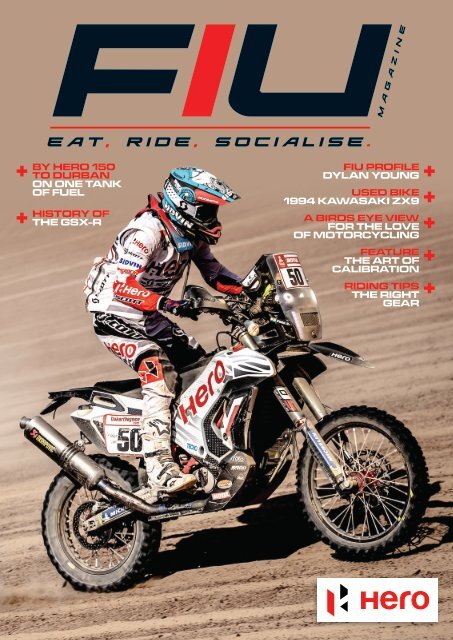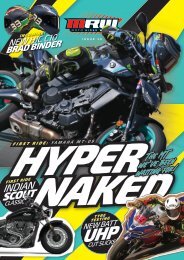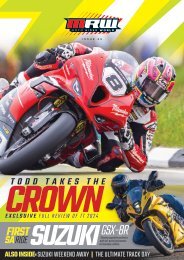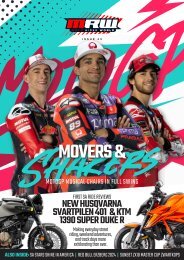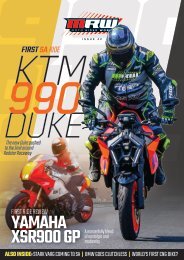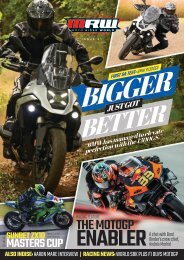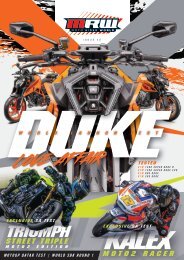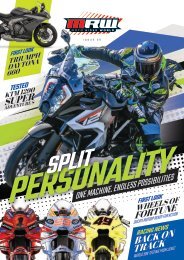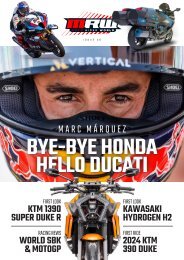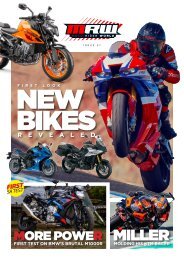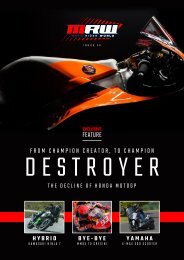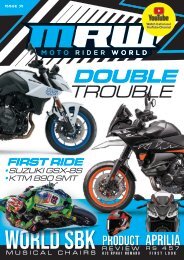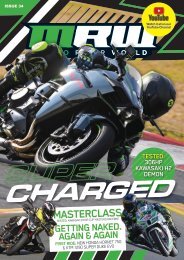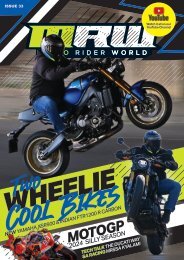FIU Magazine issue 1
You also want an ePaper? Increase the reach of your titles
YUMPU automatically turns print PDFs into web optimized ePapers that Google loves.
BY HERO 150<br />
TO DURBAN<br />
ON ONE TANK<br />
OF FUEL<br />
HISTORY OF<br />
THE GSX-R<br />
<strong>FIU</strong> PROFILE<br />
DYLAN YOUNG<br />
USED BIKE<br />
1994 KAWASAKI ZX9<br />
A BIRDS EYE VIEW<br />
FOR THE LOVE<br />
OF MOTORCYCLING<br />
FEATURE<br />
THE ART OF<br />
CALIBRATION<br />
RIDING TIPS<br />
THE RIGHT<br />
GEAR
Welcome to the new <strong>FIU</strong> <strong>Magazine</strong> which is now<br />
available in print! After the success of our first<br />
magazine which was digital only, I wanted to improve<br />
the content and make it applicable to all audiences.<br />
We also wanted a monthly magazine so that we<br />
could communicate with our customers and friends<br />
regularly. Harry Fisher is the Editor of the magazine<br />
(proudly) and has some great ideas on new content<br />
from Motorcycle reviews, Places to ride, Riding Tips,<br />
Technical Tips, customer reviews and Fire It Up<br />
events. Why printed? For me nothing feels better than<br />
paging through a magazine. The magazine will be<br />
available to all customers who purchase a motorcycle<br />
and will also be available monthly in a digital version<br />
to existing customers and friends. Let Harry and I<br />
know what you think and lets makes this magazine<br />
yours as much as ours.<br />
Craig Langton
Fire It Up<br />
Profile<br />
Dylan<br />
Young<br />
In some workplaces, you’ll see a supposedly<br />
funny sign saying, ‘you don’t have to be mad to<br />
work here, but it helps!’ At Fire It Up, you don’t have<br />
to be mad in the slightest, but you do have to have<br />
passion, integrity, skill and a dedication to service.<br />
When Dylan Young walked in to meet Craig<br />
Langton for his interview, Craig knew immediately<br />
that Dylan had all those qualities and, three short<br />
months later, he has already proven himself a<br />
valuable member of the <strong>FIU</strong> family.<br />
At the age of 26, Dylan might be young, but he’s<br />
been riding motorcycles since he was 10. Like so<br />
many youngsters, he started on a small dirt bike<br />
and progressed to a Kawasaki Ninja 250 at 16. An<br />
accident put paid to that bike and it was replaced by<br />
a Big Boy 200 that lasted a couple of years before<br />
he headed for the big time with a Yamaha R1,<br />
something of a dream bike for a long time.<br />
It’s no small thing to leap from a 200cc to a<br />
1000cc bike but it says a lot for Dylan’s skill behind<br />
the handlebars that he made the transition without<br />
trouble.<br />
The job at Fire It Up enabled Dylan to marry his<br />
experience in sales and his skill in dealing with<br />
people with his passion for motorcycles. If there’s<br />
one thing that unites all the employees at Fire It Up,<br />
it’s the passion for motorcycles first and foremost,<br />
with strongly held values of customer service and<br />
integrity coming in a very close second.<br />
Dylan is quick to see opportunities to grow<br />
and develop at Fire It Up and he clearly has his<br />
sights set on bigger things. There is always so<br />
much going on at <strong>FIU</strong>, be it getting involved with<br />
the opening of new branches or helping with<br />
getting the Hero brand up and running in South<br />
Africa. Owning a Big Boy might, at the time, have<br />
seemed like a downgrade from the Kawasaki<br />
but it is paying dividends now as he can directly<br />
compare it with the impressive Hero models now<br />
sharing floor space at <strong>FIU</strong> with some of the world’s<br />
best motorcycles. It is that insight that makes a<br />
salesman invaluable.<br />
Being open seven days a week is a challenge that<br />
could put some people off but Dylan is determined<br />
to repay the faith Craig has in him.<br />
‘The atmosphere at <strong>FIU</strong> is high energy and<br />
definitely customer-focussed.’ Dylan says. ‘No-one<br />
walks in here without being seen and approached,<br />
which might seem obvious, but it’s not always<br />
the case in many other dealerships; this is what<br />
sets us apart. We’re here not simply to sell you a<br />
motorcycle but to take you through every step of the<br />
advising and buying process so it is less daunting.<br />
‘And, at the end of that process, It’s not about<br />
handing over the key and waving goodbye. It’s about<br />
developing the relationship and staying connected<br />
with the customer so that they want to come back,<br />
allowing us to look after them and their bikes. The<br />
focus is on making sure the client has the support<br />
so that they feel confident in us. That’s why I really<br />
enjoy working here.’<br />
Of course, communication between salesman<br />
and customer is helped by the warranties and<br />
service plans that Craig and the team have worked<br />
hard to develop to protect the consumer as far<br />
as possible. With all this in place, the after-sales<br />
support can be of a very high level, which helps the<br />
staff at <strong>FIU</strong> perform to their highest level.<br />
Dylan is quick to acknowledge Craig’s influence<br />
over the whole of Fire It Up. He could have been<br />
overawed but Craig was quick to put him at ease;<br />
’He’s always got time for his staff;<br />
he’s as much of a mentor as a boss. We<br />
can go to him with anything at any<br />
time because he knows that his staff<br />
are the life of the business and if the<br />
staff aren’t happy, then the business<br />
won’t run smoothly.’<br />
Anyone who has been to Fire It Up can attest<br />
to Craig’s lead-from-the-front style - he’s always<br />
there, always looking at the details and he expects<br />
his staff to have the same attitude. In Dylan Young,<br />
he has exactly the type of team member he needs;<br />
passionate, ambitious, willing to learn, friendly; a<br />
people person. If Craig has given him the break, it is<br />
certain that Dylan will grab the opportunity with both<br />
hands and make a success of it. Because of that<br />
attitude, both Fire It Up and the clients will benefit.
Used Bike<br />
Profile<br />
1994 Kawasaki<br />
ZX9<br />
7,800km | R89,000<br />
One of the fun things about walking in to Fire<br />
It Up on any day is the chance that you might see<br />
something unexpected, rare or, at the very least,<br />
interesting. What makes it all the more special is<br />
that the bikes are usually in time-warp condition,<br />
with ridiculously low mileages and a reasonable<br />
price tag.<br />
One such bike that caught my eyes the other day<br />
was this beautiful Kawasaki ZX9R and it hails from<br />
a very interesting period in sports bike design.<br />
The ZX9R was developed in response to the<br />
new Honda CBR900RR Fireblade, which was a<br />
game changer in itself. Before the Fireblade, large<br />
capacity Japanese sports bikes stood in one of<br />
two camps; on one side were the 750cc sports<br />
models and on the other were the 1000cc+ sports<br />
touring models that were a direct development of<br />
performance bikes of the last 20 years. The 750s<br />
had the handling, the 1000s had the power.<br />
Kawasaki were top dogs in both categories.<br />
The ZXR750 gave performance and incorporated<br />
technology of the racing-homologation models<br />
from Honda and Yamaha at half the price, while the<br />
ZZ-R1100 was the fastest production motorcycle on<br />
the planet.<br />
Then came the Fireblade, with a 900cc engine<br />
in a 750-sized chassis. It offered an unbeatable<br />
mixture of power and handling; it was lighter than<br />
the 750s but with more power and a chassis that<br />
could handle it. Kawasaki had to respond - as<br />
did Yamaha and Suzuki - but you could say that<br />
Kawasaki, in developing the ZX-9R as a rival to the<br />
Honda, ignored the lessons the Fireblade<br />
was trying to teach.<br />
Kawasaki combined the 1100 and the 750 rather<br />
than developing a completely new motorcycle. The<br />
result was that it was heavy - almost 30kg more<br />
than the ‘Blade - although it produced 10-15bhp<br />
more. But the extra power couldn’t make up for the<br />
size, weight and reduced agility.<br />
Thus Kawasaki positioned the ZX-<br />
9R as a more stable, comfortable<br />
and quicker-in-a-straight-line<br />
alternative to the ‘Blade. History<br />
shows us that this was a bit of a copout<br />
for Kawasaki and they soon<br />
rectified their mistakes with the<br />
later generations of superbikes.<br />
All of the above doesn’t mean that the ZX-9R<br />
is not worth a very close look. In all reality, the<br />
qualities of the ‘Blade were beyond the average<br />
rider and the Kawasaki was no different.<br />
The ZX9R might have been designed as a sports<br />
bike but in actual fact was much better when<br />
viewed as a sporty sports tourer. It might have been<br />
too big and heavy as a track tool, especially when<br />
compared to the Fireblade, but as a road bike, it<br />
was superb; fast, roomy, comfy - even two up - and<br />
was possessed of solid and secure handling. Fast,<br />
good looking and useful; it’s a heady mix. Add in<br />
rare and sought after and it would be a surprise if<br />
the example sitting on the floor at Fire It Up sticks<br />
around for very long.
‘A Birds Eye View’<br />
For the love<br />
of motorcycling<br />
BY Mishka Moller<br />
Lady Riders. Why do we ride? Is it the freedom, adventure,<br />
adrenaline, spiritual experience, confidence, independence,<br />
or the biking community? Perhaps a bit of everything? It does<br />
not matter, because women are taking to motorcycles with an<br />
increased voracity and I love it!<br />
My motorcycling journey started 26 years ago with renowned,<br />
now late, Dirk Du Plooy at his training yard in downtown Jozi. I<br />
was so tense that my body ached two days after the weekend<br />
riding course. In spite of stressing about learning how to coordinate<br />
all this stuff: shifting gears, cornering, looking ahead<br />
and all those other terrifying simultaneous things you have to<br />
do when learning to ride – I passed my bike licence first time<br />
round – personal challenge accomplished! I had finally embraced<br />
my freedom, which also served as a catalyst for other incredible<br />
life changes. I knew that I could do anything I set my mind to.<br />
Actually, it was all about relinquishing the fear and embracing<br />
that cliché called freedom.<br />
To this day, when I get onto my motorcycle, I say a little prayer, I<br />
embrace the fear and within minutes in the saddle, my confidence<br />
is up and soon the magic soars within me – it’s an all embracing<br />
feeling, the feeling of being whole and that I can accomplish<br />
anything!<br />
When I’m riding – I’m in my happy place. It’s<br />
me-time in my helmet,
Personally, there’s no cell phone, no<br />
music or other distractions that interrupt<br />
this timeless magic on my motorcycle; just<br />
the smells and the excitement of the ride.<br />
No matter how long or how short the ride is,<br />
I look forward to ‘time in my helmet’. Mostly<br />
I’m riding with my besties, so a doublewhammy<br />
happy place!<br />
Whilst riding is often about independence,<br />
I appreciate the brotherhood and sisterhood<br />
of the biking community. When I first started<br />
riding with a club as a single women in my<br />
twenties, I was respected, treated equally<br />
and at the same time looked after so well<br />
– without feeling inferior. There was no<br />
intimidation, just a bunch of like-minded<br />
people with the same crazy desire to ride<br />
and have fun! I welcomed the support and<br />
still ride with that core group today. My club<br />
celebrates 30 years this year and the same<br />
people I met then, are still riding with the club<br />
– from strangers to friends; these people are<br />
now my family. I’m so proud to call them that!<br />
I realised that if you can master your<br />
motorcycle, you can master anything. It<br />
changed my entire way of thinking and my<br />
outlook on the world that I too encouraged<br />
more women to ride. Women on motorcycles<br />
are a beautiful and powerful thing!<br />
The last 26 years of riding, I have been<br />
involved with many riding communities<br />
including official dealership chapters,<br />
cruiser riding communities locally and<br />
internationally.<br />
In 2000, I started a riding academy with<br />
renowned Grant McCleery at Gerotek which<br />
we ran for 10 years. I sat on the board of<br />
AMID (Association of Motorcycle Importers &<br />
Distributors) representing Harley-Davidson<br />
SA. I was involved with Cancervive as Lead<br />
Rider for many years. Over the years I got<br />
involved with adventure riding & tours, and<br />
later on Enduro clubs and tours – locally<br />
and internationally. I’m deeply grateful for<br />
the privilege of being fully involved in the<br />
motorcycle fraternity.<br />
I have arranged and attended motorcycle<br />
launches over the years, it even took me to<br />
Sicily two years ago to test ride a new cruiser<br />
tyre for Metzler. There is so much that<br />
encompasses the moto-life that riding and<br />
being part of the riding fraternity becomes<br />
your life – could a girl get any luckier?<br />
So why all this banter? Well – we now<br />
have a dedicated column to share all things<br />
relevant for biking ladies embracing things<br />
like biker fashion, perceptions, where to go<br />
& what to do from a beginner to an advanced<br />
level with simple riding tips and anything<br />
that we find hip and happening!<br />
Oh and if there’s anything you a woman<br />
need to know – feel free to reach out, that’s<br />
what we are here for! See you on the road x
By<br />
Hero 150<br />
to<br />
Durban<br />
(On One Tank Of Fuel)<br />
Those who don’t know will say that anyone who<br />
rides a motorcycle must have a screw loose. To<br />
those of us who do know, we know there is no<br />
better way of tightening that screw than riding a<br />
motorcycle.<br />
Having said that, even experienced motorcyclists<br />
look at some feats of riding that make them wonder<br />
if there might not be a grain of truth in the ‘screwloose’<br />
theory.<br />
Many of us have undertaken a long motorcycle<br />
journey. Many of us have undertaken them on<br />
slightly unsuitable bikes. But there can’t be many<br />
of us who have done them not only on unsuitable<br />
bikes but also with one arm tied behind their<br />
backs, so to speak.<br />
But that is exactly what Prabhu Subramoney<br />
(you’ll know him better as Prabs, Operations<br />
Manager at Fire It Up) did one day in May. Not<br />
content with proving that the new Hero Eco<br />
150cc De Luxe could easily handle a trip from<br />
Johannesburg to Durban, he did it avoiding the N3<br />
highway in its entirety, taking only minor roads.<br />
Nothing surprising in that, you’d say. But what if we<br />
also told you he did it on one, 13-litre tank of petrol?<br />
That’s 651km on 13 litres of petrol. And he still had a<br />
litre of petrol left when he reached Ballito!<br />
But why do it in the first place? It might be best to<br />
let Prabs take up the story.<br />
“The challenge was to prove a few things. First<br />
and foremost was the economy of the motorcycle.<br />
It’s been proven that it can do 66km/litre in<br />
controlled conditions. But we wanted to prove what<br />
it could do in real-world conditions.<br />
“Secondly, we wanted to prove that you could<br />
spend 14-hours in the saddle of this small bike<br />
without needing an osteopath at the end of it! The<br />
comfort was amazing and, with the engine having<br />
a balancer shaft, it makes it so much smoother,<br />
making that long day in the saddle that much easier.<br />
I woke up the next day feeling as fit as when I set off.<br />
“Third - and certainly not least - was to<br />
demonstrate the quality of the bike. For example,<br />
being on non-highway roads, there were plenty of<br />
potholes, not all of which I could avoid. Add to that<br />
the fact that sometimes the GPS directed me onto<br />
dirt roads which could have shaken the bike to<br />
pieces but, when I stopped, nothing had come loose<br />
- not a nut or a bolt.”
Obviously, Prabs couldn’t go flat out all the way;<br />
it was a balancing act between speed and fuel<br />
consumption.<br />
“At first I was being over-cautious<br />
and sat at between 65-75km/h but<br />
once I got into a rhythm, I could<br />
sit at around 80km/h, which is<br />
a decent speed. In some places, I<br />
could go faster as I was on the right<br />
side of fuel consumption but the<br />
critical thing was to keep the revs<br />
between 5,500 and 6,000, which<br />
takes a lot of mental control and<br />
that’s where the comfort played its<br />
part as that didn’t distract me.”<br />
It is important to note that the Eco 150 was<br />
absolutely bog standard in every respect; nothing<br />
had been modified at all although extra LED lights<br />
were fitted at the front for safety, which was just as<br />
well as Prabs had to not only watch the fuel gauge<br />
but also the weather.<br />
“There was a lot of mist and fog as I climbed into<br />
the KZN mountains - I had zero visibility and that<br />
cut my speed to 20km/h as I couldn’t see a thing!<br />
Breaking down in such conditions wouldn’t have<br />
been ideal; my only objective was to keep going and<br />
the Hero removed all such worries.”<br />
The ride wasn’t just some publicity stunt; this<br />
was, in effect, a recce for a brand new event that<br />
Fire It Up is planning.<br />
“We would like to initiate an annual adventure<br />
challenge and my ride was essential for us to<br />
understand the terrain and challenges; we have a lot<br />
more information about how it can work,’ said Prabs.<br />
“It will run along exactly the same lines as what I<br />
have just achieved; get to Durban from Johannesburg<br />
on one tank of fuel but this time there will be a<br />
set time that it must be achieved in. Everyone will<br />
have to follow largely the same route and there will<br />
be checkpoints at various stages along the way,<br />
although between those checkpoints the competitors<br />
will be free to take whatever route they like, obviously<br />
without extending the mileage too much.<br />
“We know that the bikes won’t break down; the<br />
only reason you won’t reach the finish is because<br />
you’ve run out of fuel.”<br />
Is it a race, or is it a regularity run, along the lines<br />
of the economy runs so popular at one time?<br />
“We’re thinking of it as an adventure challenge,<br />
the adventure being exploring parts of the country<br />
that you miss when belting down the highway to<br />
Durban. We want people to experience this amazing<br />
country of ours and what better way than from the<br />
saddle of a motorcycle? It’s not about simply getting<br />
from point A to point B, it’s about the experiences<br />
along the way. It will be hard but it will also be fun.<br />
At each checkpoint there will be clues to where you<br />
need to head for on the next leg. Of course, safety is<br />
a big consideration but even taking that into account,<br />
we know it will be a lot of fun.<br />
“People were asking if it wasn’t dangerous, riding<br />
so far without any back-up or support vehicle and<br />
Photo credit: Bjorn Moreira / ZA Bikers<br />
I have to tell them, ‘no, not at all.’ I had a tracking<br />
device on the bike so the guys back in Johannesburg<br />
could see exactly where I was and, let’s face it, if<br />
anything had gone wrong, there will always be<br />
someone who is willing to help, no matter how<br />
remote the location. This is one of the challenges; if<br />
something does go wrong (not that it will do - you’re<br />
riding a Hero!), how do you rectify it and get on your<br />
way again?”<br />
There is already a lot of interest in the event, the<br />
first of which should be in early spring of this year.<br />
People are realising that you don’t have to be riding<br />
a big motorcycle to have fun or to meet a challenge.<br />
If you are one of those adventurous types and fancy<br />
giving it a go, then get in touch with the good people<br />
at Fire It Up and register your interest and let’s see<br />
what happens in September!
PICTURED LEFT:<br />
1985 GSX-R750<br />
PICTURED RIGHT:<br />
1986 GSX-R1100<br />
Given the fact that Fire It Up sell all makes and models of<br />
motorcycles, we thought that it might be useful to trace the history of<br />
various well-known and long-lived models. This month, we kick off<br />
with the Suzuki GSX-R.<br />
By the end of the 1970s, the first generation of so-called<br />
superbikes - Honda’s CB750, Kawasaki’s Z900, Suzuki’s GS range<br />
- were getting long in the tooth. A new generation of performance<br />
motorcycles was needed; Honda pointed the way in 1983 with its<br />
VFR750 and Kawasaki announced the GPz900R Ninja a year later.<br />
Suzuki looked closely at this new generation and wanted in on<br />
the act. The very first GSX-R was the GSX-R400 for the Japanese<br />
market. It’s trump card over other 400cc bikes on the market was its<br />
light weight. Suzuki decided it could do the same in the 750cc class.<br />
The engine of the new-for-1984 GSX-R750 was a DOHC, four<br />
cylinder, just like its contemporaries. But where it differed was in<br />
using oil to cool parts of the engine blocked off from cooling air,<br />
such as the top of the combustion chamber. This air/oil system was<br />
called Suzuki Advanced Cooling System, or SACS for short.<br />
The the flat nose and dual headlight styling had its origins in<br />
endurance racing; the regulations decreed that the headlight must<br />
be behind the axle line of the front wheel. Endurance racers used<br />
twin headlights for obvious reasons.<br />
HISTORY<br />
OF THE<br />
SUZUKI<br />
GSX-R
Weight was carefully monitored. Parts would be tested, then<br />
lightened, then tested again, then lightened, until they finally<br />
broke. That’s how they found the limits. The rear suspension was<br />
also worked on to reduce weight and lower the centre of gravity.<br />
The GSX-R750 was released in 1985 and, a year later, the<br />
GSX-R1100, with its 1052cc engine, was released, remaining<br />
faithful to the mantra of the lightest weight possible, combined with<br />
extremely strong mechanicals.<br />
At the time, reviewers hailed the power, handling and weight of<br />
the new kid on the block. Of course, in comparison with what came<br />
later, especially in the form of the Fireblade, it retrospectively looked<br />
large, heavy and unstable, but that was all in the future. For now,<br />
Suzuki had a winner on its hands.<br />
In 1989, the ‘K’ model was introduced, using the new 1127cc<br />
engine. Weight had crept up thanks to a shorter, stiffer (and heavier)<br />
frame but handling was slightly suspect, possibly due to badly setup<br />
suspension. It gained a reputation for ill-handling that wasn’t<br />
helped by the death of Phil Mellor at the TT in 1989 on his ‘K’ model<br />
GSX-R1100. James Whitham also crashed his GSX-R out of the race.<br />
1989 GSX-R750<br />
1993 GSX-R1100<br />
In 1990, the ‘L’ model was released, with a longer wheelbase to<br />
address the problems with the handling. 1991 saw the ‘M’ model,<br />
which was changed cosmetically and then the ’N’ model which also<br />
had further cosmetic changes.<br />
The next big change came in 1993 with the adoption of water<br />
cooling, which brought an increase in power to 155bhp at the crank.<br />
As with all Suzukis the new engine was extremely strong and could<br />
be tuned to give another 30% power without the need for forced<br />
induction. These new models were designated WP and, several<br />
variations, named WR, WS, WT, WV and WW, followed. Most of the<br />
changes were cosmetic and the engine and suspension and other<br />
components were mildly tweaked.<br />
1998 saw the last of the 1100s and it would be a three year wait<br />
until it was properly replaced.
2001 GSX-R1000<br />
2001 GSX-R750<br />
“After 10 years of GSX-R production, both the 750<br />
and 1100 had evolved with the times. 1996 however<br />
introduced the first of a new type of GSX-R750. With<br />
the demands of faster racers and road riding, the<br />
future was bigger airboxes and stiffer chassis. Enter<br />
the GSX-R750 SRAD. It brought the relationship<br />
between race bikes and road bikes even closer than<br />
it had been before. The dimensions of the new 750<br />
were based on those of Kevin Schwantz’s 1993 World<br />
Championship winning RGV500.”<br />
The success of the Fireblade and the Yamaha<br />
R1 forced Suzuki to take action and, in 2001, it<br />
launched the GSX-R1000. The starting point was<br />
the GSX-R750, with suitably strengthened frame<br />
and the engine was a development of the 750cc<br />
engine, with power up to 160bhp at the crank.<br />
Crucially, the GSX-R1000 was lighter and more<br />
powerful than the R1.<br />
2003 saw the introduction of the K3 model,<br />
which was lighter, produced more power and<br />
handled better. The K4 (2004) model continued<br />
without any major changes.<br />
2005’s K5 had a redesigned engine and chassis<br />
to further aid performance and handling and<br />
further reduce weight. The changes were small<br />
and incremental but had positive effects on<br />
handling and performance. Negative effects of<br />
the weight saving on the chassis included some<br />
instances of cracks appearing in the frame.<br />
2007’s K7 saw yet more revisions, this time<br />
including an increase in weight, albeit by only<br />
a small margin due to the increasingly strict<br />
emissions regulations. To counter these, Suzuki<br />
paid attention to aerodynamics and equipped the<br />
bike with two power modes; A (unrestricted) and B<br />
(reduced power until half-throttle is applied).
2005 GSX-R1000<br />
2007 GSX-R1000 2012 GSX-R1000<br />
What can be gleaned from all the above is that<br />
the story of the GSX-R1100 and 1000 is a stream<br />
of steady development over the years, helping the<br />
‘Gixxer’ keep up with the competition and making<br />
it easier to ride.<br />
The K9 and L0 GSX-R1000s marked the turn<br />
of the decade and they moved the GSX-R1000 on<br />
in its development once again. Like the changes<br />
to the 600 the previous year, the 1000 found<br />
itself benefitting from an entirely new engine,<br />
chassis, suspension and brakes. Being a 1000cc<br />
sports bike, the changes were all developed on<br />
the race track. But what it still retained was its<br />
road bike manners. Bike magazine claimed, “It<br />
has the most legroom, the plushest seat and the<br />
most effective screen in its class.” Traits that the<br />
GSX-R1000 has carried with it since.<br />
In 2012 the GSX-R1000 received similar<br />
updates to those the 600 and 750 benefitted<br />
from the year before. It was launched in Miami<br />
at the Homestead Raceway. In the same year,<br />
worldwide production of GSX-R topped one<br />
million units. Thay year, GSX-R mounted riders<br />
took championship titles across the globe,<br />
including in Australia, Sweden, and Poland. Josh<br />
2017 GSX-R1000<br />
Brookes would have taken the British Superbike<br />
crown on the conventional point scoring system,<br />
finishing every race and notching 20 podiums<br />
along the way.<br />
The 2012 updates to the GSX-R1000 were<br />
made to offer heightened engine and chassis<br />
performance as well as weight-loss for overall<br />
performance. Two kilos were lost over the<br />
development process and new monobloc<br />
calipers from Brembo to offer improved braking<br />
and reduced fade on track. Newly developed<br />
pistons with MotoGP derived technology<br />
reduced the moving mass by 11%, improving<br />
acceleration and response.<br />
Over the next ten years, this programme<br />
continued until we get to the 2017 GSX-R1000.<br />
This L7 model introduced mechanical variable<br />
valve timing to the engine. It was also the first<br />
GSX-R to get traction control courtesy of the<br />
inertial measuring unit and ride-by-wire throttle.<br />
Not only that - and this is hard to believe - but it<br />
was also the first GSX-R to have a fuel gauge…!<br />
Also announced was the R version, with quick<br />
shifter and launch control and uprated Showa<br />
suspension.<br />
The Suzuki GSX-R1100 and 1000 models have<br />
always had a strong and loyal following and that<br />
looks set to continue into the third decade of the<br />
2000s.<br />
“For the first time in the company’s<br />
history the new bike featured all<br />
mechanical VVT technology - variable<br />
valve timing derived from the MotoGP<br />
GSX-RR machine, allowing for a<br />
more linear and manageable power<br />
band throughout the whole range. A<br />
quickshifter and auto-blipper were<br />
added for clutchless shifting up and<br />
down the box. Lean sensitive traction<br />
control, Showa Balance Free Forks,<br />
Brembo monobloc calipers, ABS, launch<br />
control, and multi-setting traction<br />
control were among the new features<br />
added. With 200hp and a weight of just<br />
over 200kg, it is the fastest, hardest<br />
accelerating, best performing GSX-R<br />
ever produced.”
Workshop Tip<br />
Fire It Up Tribe<br />
For the Fun Of It<br />
When you buy a motorcycle from Fire It Up, you are doing so much more than purchasing a<br />
mode of transport; you become part of a family and, like all families, we like to get together to<br />
have some fun.<br />
The Fire It Up Tribe was conceived to bring all motorcyclists together, no matter what they<br />
ride or how experienced they are. Motorcycling, by its very definition, is a solo pursuit but,<br />
having said that, we love doing nothing more than getting together to share the passion we<br />
all feel for it.<br />
Every month we organise events to which all Tribe members are invited. These range<br />
from Sunday morning breakfast rides, to MotoGP Sundays hosted at Fire It Up, with all<br />
three races being shown on big screens and themed meals being available from the<br />
Fire It Up Diner. We have new member evenings where you can meet Donovan Fourie<br />
and Harry Fisher, who organise the club events, and some of the team from Fire It<br />
Up, where we explain what the Tribe is all about and what you can expect.<br />
We’ll have technical evenings, movie nights and mid-week night rides.<br />
Once or twice a year, we’ll organise a weekend run to get us properly out of<br />
the city, with an overnight on Saturday where we can all let our hair down.<br />
The important thing to remember is that this is your club, so if you have any<br />
suggestions, we would love to hear them and will happily include them in<br />
the itineraries.<br />
Being a member of the club also brings benefits at Fire It Up, from<br />
free coffee at the Diner to discounts on some of the many services<br />
offered at Fire It Up. Talk to any of the lovely people at Fire It Up for<br />
more details. Or you can follow us on Facebook. Look up Fire It<br />
Up Tribe Group and you can ask to become a member and get<br />
all the notifications. Ask anyone at Fire It Up to be added to<br />
the WhatsApp group as well.<br />
Welcome to the Tribe.<br />
Oiling<br />
Your<br />
Chain<br />
If there’s one thing that you have do yourself,<br />
regularly, it is to lubricate your chain. The advent of<br />
the ‘O-ring’ chain has made this less essential than<br />
previously, or maybe it would be more accurate to<br />
say that intervals between lubrications has been<br />
extended, even if the need to has not.<br />
Lubrication will not only extend the life of the<br />
chain but also the gearbox and rear sprockets<br />
and help with quieter running. So often I hear<br />
the argument that, because it doesn’t rain at all<br />
in Gauteng during winter, then there is no need<br />
lubricate because water spray won’t wash away the<br />
film of oil on the chain.<br />
What these people fail to realise is that the lack<br />
of rain only serves to increase the amount of dust,<br />
which is fantastically abrasive. With no filter, such<br />
as you find cleaning air before it enters the engine<br />
or oil in the engine, a chain is extremely exposed<br />
and therefore needs all the help it can get to give<br />
long life.<br />
If your bike has a centre stand, then cleaning and<br />
oiling a chain is simplicity itself. Take a soft brush<br />
and scrub away any congealed oil and gunk (Bike<br />
Kings sell specialised chain brushes). Then, with<br />
the bike on its centre stand, spin the back wheel and<br />
aim the jet of lube from the can onto the inside of the<br />
chain, the part that actually touches the sprockets.<br />
Easy as that. Give it a few minutes to set and you’re<br />
good to go. Modern lubes have anti-fling properties<br />
so you shouldn’t find your back wheel rim covered in<br />
gunk after the first ride.<br />
If the chain is really dirty, as it can get on<br />
adventure or off-road bikes, you can buy spray chain<br />
cleaner which will loosen caked on muck making<br />
it easier to brush off. Never be tempted to use a<br />
pressure washer; water will penetrate the rollers<br />
and stuff them up and there is the danger that you<br />
could get a blast of water into the wheel or swing<br />
arm bearings, rinsing out any grease.<br />
But what happens when you don’t have a centre<br />
stand, only a side stand? Well, you can clean and<br />
lube the bit of chain you can see, then wheel the bike<br />
forward to expose the next bit of chain. That’s a bit of<br />
a faff, so try this;<br />
Put the bike on its side stand. Take your car’s jack<br />
and place it under the rear tip of the swing arm on<br />
the opposite side to the side stand. Slowly raise the<br />
jack until the rear wheel has just left the ground so it<br />
will spin freely as if the bike is on a centre stand. Hey<br />
presto, you can now clean and lube the chain. Make<br />
sure to do it on level ground and place a chock in<br />
front of the front wheel so the bike can’t roll forward<br />
and off the side stand.<br />
It may sound simple, lubricating your chain, but<br />
often it is the small things that will keep your bike<br />
running properly.
THE ART OF CALIBRATION<br />
(NOT ’TUNING!’) By;<br />
It seems like a short while ago when Euro 4 was introduced<br />
the tuning industry was shaken as no longer could you simply<br />
fit an exhaust or a Fuel Module and disconnect lambda sensors.<br />
Many customers still fitted full system exhausts or removed their<br />
catalytic converters only to discover bikes were harder to ride and,<br />
as the ECU became more confused, the bikes became slower.<br />
Now that Euro 5 is the new standard in motorcycles, tuning has<br />
become more complex than ever and simply fitting a full system<br />
exhaust can destroy an engine without the proper supporting ECU<br />
Software or Euro 5 compliant fuel module. The latest motorcycles<br />
are expected to run extremely lean to comply with these<br />
restrictions, as a result creating high engine temperatures.<br />
Dean Michau<br />
Simply put the old tuning days are done<br />
forever. Today making a motorcycle perform<br />
better, smoother, more responsive and<br />
run cooler is managed in a number of<br />
different ways but to give you an idea, a Euro<br />
5 motorcycle has a complicated ECU Map<br />
structure which looks like this: (pictured right)<br />
Calibrating a motorcycle for best<br />
performance really comes down to removing<br />
the restrictions put in place to achieve Euro<br />
Emission regulation compliance from a C02<br />
and a noise perspective, using carefully studied<br />
methods to de-activate cold start and exhaust<br />
flaps when full system exhausts are used.<br />
This is carefully managed in a multiple of fuel<br />
maps, timing maps and throttle maps in all the<br />
different rider modes. If you view the attached<br />
MAP structure you will notice the complexity.<br />
These MAPs are modified in SA and sold all<br />
over the world.<br />
When talking to customers I don’t like using<br />
the word tuning as it is often synonymous with<br />
making an engine perform at beyond what<br />
it was designed for, revving the hell out of it<br />
on the Dyno searching for more power which<br />
ultimately causes premature wear or failures. I<br />
prefer the term ‘calibration’ which coincidently<br />
is also used by the technology manufacturer<br />
we represent, Dimsport, who are world leaders<br />
in Engine Calibration supplying equipment,<br />
Software and Rapid Bike Fuelling modules.<br />
Dimsport/Rapid Bike are the only company<br />
in the world capable of managing the Euro 5<br />
fuelling requirements every 10 milliseconds!<br />
Although the device is a plug and play (it still<br />
requires dealer fitment) it is supplied calibrated<br />
for the particular brand and obviously warranty<br />
friendly.<br />
Over the last year or so, Dimsport/Rapid<br />
Bike became official tuning partner for<br />
Akrapovic which has seen major developments<br />
in engine calibration and therefore the<br />
technology is used in our National Race Bikes<br />
and a large number of the WSBK bikes.<br />
Over the next <strong>issue</strong>s of the magazine, you<br />
can expect us to dive deeper into certain areas<br />
covered above!
RIDING TIPS<br />
The Right<br />
Gear<br />
Now, to most of you out there, the answer to<br />
what to wear when riding a motorcycle is pretty<br />
obvious and it can be summed up in one easy<br />
acronym; ATGATT - All the Gear, All the Time. It’s<br />
only a complete fool who ventures out on the roads<br />
without, at the very least, the whole of his or her<br />
body being completely covered, even if it is not all<br />
dedicated motorcycling gear. Protection against<br />
abrasion or impact will be limited but it’s better<br />
than nothing. The only problem in our chosen<br />
mode of transport is that, better than nothing is<br />
never good enough.<br />
But what about those of you new to riding and<br />
maybe on a budget? Are you properly protected?<br />
Can you afford not to be?<br />
When I lived in the UK, it was pretty difficult to<br />
venture out on a bike without wearing plenty of<br />
protective clothing and that can be summed up in<br />
one word; weather! I got so used to always having<br />
to wear protective gear - protective against the<br />
elements if nothing else - that when I came to SA<br />
I found it impossible to ride without at least a good<br />
jacket and jeans; it just felt wrong.<br />
Here in South Africa, we don’t have the problems<br />
of an English climate. At least, not in the same<br />
sense. What we do have here is extremes of<br />
weather, no matter in what province you ride.<br />
We all know what it is like riding in the heat of<br />
summer; sometimes unbearably hot, especially if we<br />
are riding a bike with huge acres of wind protection.<br />
Similarly, in winter, it might be freezing cold in the<br />
early mornings and late evenings but, in the middle of<br />
the day, it can still get warm - I hesitate to say hot! -<br />
leaving you stripping off layers like mad. And let’s not<br />
pretend that we don’t get rain!<br />
It’s expensive to have a range of gear in your<br />
cupboard that can cope with all weather conditions,<br />
let alone carrying it all with you; ventilated for<br />
heat, insulated for cold, waterproof for wet. There<br />
is nothing more uncomfortable than wearing the<br />
wrong gear for the conditions; too hot, too cold<br />
or simply wet through. Not only that, but it is<br />
also dangerous; concentration suffers if you are<br />
uncomfortable.<br />
There are many solutions out there. I own a jacket<br />
that is a ventilated jacket on the outside but has<br />
a thermal and a waterproof lining that are easily<br />
zipped out. Thats the best of all worlds but not all<br />
styles of jackets come in such practical forms. It’s all<br />
about compromise; buy the best and most versatile<br />
jacket you can afford. Also, look for one that has<br />
CE approved armour built in on elbows, shoulders<br />
and back; the bits that stick out and really need<br />
protecting. Take a look at this Next Ikaro jacket; full<br />
airflow with a zip-out waterproof lining for R2,600.<br />
Another option is to own a ventilated jacket for<br />
summer riding which, let’s face it, is when you<br />
will be doing most of your riding anyway, and then<br />
supplement that with a waterproof over-jacket for<br />
winter. You can wear several layers underneath for<br />
insulation. The waterproof blocks the wind perfectly<br />
with the added benefit of keeping rain out and folds<br />
up small enough to fit in a backpack when not<br />
needed. The Oxford Rainseal jacket and pants for<br />
R900 and R600 respectively do the job nicely whilst<br />
offering increased visibility in bad weather.<br />
What about the legs? There are a few brands<br />
out there that make Kevlar armoured jeans that<br />
look acceptable when off the bike, are comfortable<br />
on the bike and will protect the skin on your legs<br />
and backside when you are sliding along the road.<br />
Bike Kings at <strong>FIU</strong> stock Nexo, Tankwa and Oxford<br />
(for ladies), all for around R2,000. They might not<br />
have too much impact protection, but that is a<br />
compromise you have to decide to take.<br />
Feet and ankles have to be protected. Again, there<br />
are lots of boots out there that look like a casual boot<br />
but have hard protection built in, in addition to the<br />
more traditional riding boots. Make sure they are<br />
high enough to protect the ankle from impact and<br />
abrasion. Forma, Spirit and Alpinestars all do boots<br />
that don’t look too much like motorcycle boots, priced
RIDING TIPS<br />
Spirit Daredevil<br />
Alpinestars Faster 3<br />
from around R2,500 up to R4,000. If you want the full<br />
motorcycle boot look, then Bike Kings have boots<br />
from Alpinestars and Gaerne, but expect to shell out<br />
significantly - you’re looking at R5,000-plus.<br />
Gloves are essential. What is the first thing you<br />
do when you fall if you are walking? Put out your<br />
hands. It’s the same when you fall off a motorcycle.<br />
Some gloves come with hard plastic pucks on the<br />
palm to offer more abrasion resistance. The choice<br />
is enormous, ranging in price from around R600<br />
up to R2,000. Gloves are about the only piece of<br />
apparel where it makes sense to have a winter pair<br />
and a summer pair. If you get two years out of a<br />
pair of gloves - depending on how often you ride -<br />
you’re doing well.<br />
Of course, even the right and most expensive<br />
gear can only protect you so far but its about giving<br />
Alpinestars SMX-6<br />
Gaerne GP1<br />
yourself the best chance possible of walking away<br />
not only alive but intact.<br />
We’ve all heard the stories about someone who<br />
has come off a bike when not wearing protective<br />
gear. We’ve all seen the pictures. And yet, every day,<br />
certainly in summer, we see riders in slops and<br />
t-shirts and shorts riding around their neighbourhood.<br />
Scarily, we also see them on the highway.<br />
Now, I’m not about to get all preachy about this<br />
but the reality is that there can be no excuse for not<br />
wearing the best gear possible. To put not too fine<br />
a point on it; your life depends on it! It’s all very well<br />
investing in a good helmet, but why then ignore every<br />
other part of your body? Your head isn’t much good if<br />
there’s nothing to attach it to!<br />
Yes, it can be expensive, but so is a long stay in<br />
hospital, waiting for the skin on your legs, arms and<br />
back to grow back. Talk to one of the sales advisors<br />
at Fire It Up and Bike Kings about adding all your<br />
protective gear on to your bike finance; it’s a painless<br />
way of getting the gear you need without breaking<br />
the bank and will only add a few hundred rand a<br />
month to your repayments. Such gear can easily run<br />
to R20,000. Having said that, you could spend less<br />
than half of that and still be giving yourself sufficient<br />
protection.<br />
There isn’t a climatic condition, a style of riding or<br />
an aesthetic taste that isn’t catered for in motorcycle<br />
apparel; it’s all out there if you look hard enough. The<br />
bottom line is this; wear the right gear no matter<br />
where you are riding or how far it is. You might feel a<br />
bit silly dashing to the corner shop for a pint of milk<br />
with it all on, but not half as stupid as you will look<br />
with no skin on 50% of your body.<br />
Talk to the guys at Bike King on the first floor of<br />
Fire It Up; they’ll steer you in the right direction.<br />
Forma Creed<br />
Winter Glove<br />
Alpinestars Centre<br />
Summer Glove
Hero Eco Deluxe<br />
Commercial Pack includes:<br />
• Crash Bars<br />
• Top Box & Brackets<br />
• Licence and Registration<br />
• First Service Free<br />
• 5years/100 000km Warranty<br />
R17 999<br />
Hero ECO 150<br />
Commercial Pack Includes:<br />
• Crash Bars<br />
• USB Charger<br />
• Top Box and Bracket<br />
• Licence and Registration<br />
• 5 year/ 100 000km warranty<br />
• First Service Free<br />
• 60km/l<br />
R22 999<br />
Hero Eco 150 Trail<br />
Commercial Pack Includes:<br />
• Spoked Wheels<br />
• Crash Bars<br />
• USB Charging Port<br />
• Trail/Off-road specific<br />
• Licence and registration<br />
• Top Box and Bracket<br />
• 5year/100 000km warranty<br />
• First service Free<br />
R24 999<br />
Hero XPulse200 – SA’s new<br />
favourite! Includes:<br />
• Navigation<br />
• USB charge port.<br />
• LED Headlight<br />
• Aluminium Bash Plate<br />
• 21”Front Wheel.<br />
• 45km/l<br />
• Licence and registration<br />
• Hand Guards<br />
• Screen<br />
• LED Display including caller ID<br />
• Hurry nearly sold out!<br />
R40 999<br />
Bryanston<br />
TEL: 011 467 0737<br />
EMAIL: info@fireitup.co.za


